The Keys & Mechanism
When the keyboard and action mechanism is not in good working order, it will hold you back from becoming a good player. The condition of the keyboard and action mechanism, and how well it is regulated, has a tremendous influence on touch, control over your playing and tone production.
The keyboard is the foundation on which the action mechanism stands. When keys are not level with one another (photo below), the key-dip is also uneven. When a key is for example 1mm too high or low, the error is multiplied nearly five times (5mm) throughout the action mechanism. Keys at the 6cm, 16cm, and 23cm mark on the ruler are slanted, which also need correcting. Shims as thin as 0.025mm are used to level the keys until no light shines under the keys. The key-dip is regulated just as accurately.
When the keyboard is perfectly regulated, hundreds of very accurate adjustments are made to the action mechanism so it performs at its best, and only then will the piano be able to sound at its best.

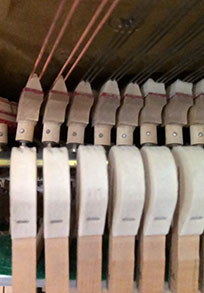 An out-of-tune piano can affect a person’s learning in terms of developing good aural skills. A piano with an action mechanism that shows wear or is malfunctioning (click photo on left to play an 18 seconds video), and is in need of regulating, will also affect a person’s learning in terms of developing a good technique, an even touch and an even tone volume.
An out-of-tune piano can affect a person’s learning in terms of developing good aural skills. A piano with an action mechanism that shows wear or is malfunctioning (click photo on left to play an 18 seconds video), and is in need of regulating, will also affect a person’s learning in terms of developing a good technique, an even touch and an even tone volume.
A piano with an uneven action and keyboard regulation will have an uneven touch, which means an uneven tone. Combined with a heavy touch, you would be “fighting” a piano like this, instead of “playing” it. It would be a big effort and hard work to play this piano and express yourself. There is a danger here of developing bad habits to make up for the shortcomings of the performance of the piano. Bad habits are difficult to unlearn, and it is much more pleasant to play a piano which plays very well.
On the other hand, a beautifully tuned piano together with an action mechanism that is well maintained and regulated on a regular basis will be a joy to play, as it is far more pleasing to the ear, and it will respond to the pianist’s fine emotional musical expressions from the softest pianissimo to the loudest fortissimo. It will motivate and inspire the player to further explore the piano and its repertoire. Regular regulating and tuning of your piano will help to maximize its value for a future trade-in or sale.
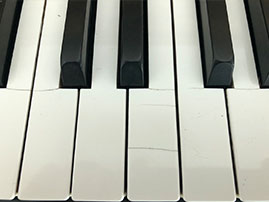 Key-tops can crack if exposed to direct heat or chemicals in cleaners. Keep the piano out of direct sunlight at all times to preserve the keys, cabinet, and tuning stability.
Key-tops can crack if exposed to direct heat or chemicals in cleaners. Keep the piano out of direct sunlight at all times to preserve the keys, cabinet, and tuning stability.
Never clean any type of keys with alcohol or spirit-based products, as the fast drying alcohol will dehydrate the key-tops, causing the key-tops to lose their shine and to crack.
Plain water is best, and if needed, add a tiny amount of liquid soap to a damp cloth. Remove any soap residue with a clean damp cloth and wipe dry. Keep the sides of the keys dry at all times.
Corroding and expanding lead weights (photo below) inside the keys of this piano caused nearly all keys to split and many ivories to come loose. The key-tops are no longer flat, making it impossible to regulate the keys and action mechanism.
A so-called “repairer” literally painted over rust, making matters much worse, and much more expensive to repair properly.
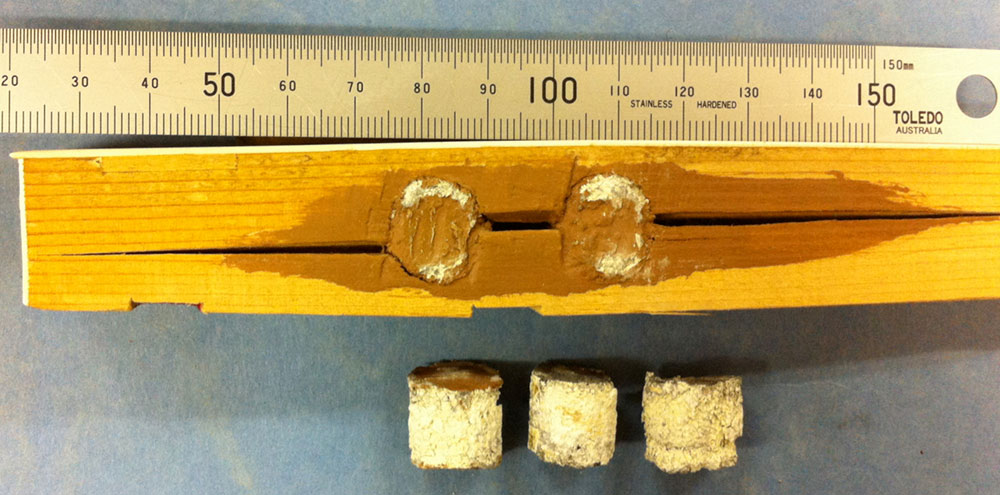
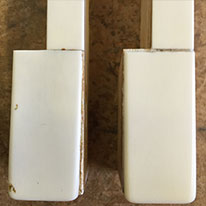 Never glue ivory key-tops back onto the keys yourself. You will do a poor job, and use the wrong glue. Most people use a clear drying wood-glue, superglue, or a contact adhesive, which are not suitable. It will make doing a proper glue job so much more difficult and expensive when we first have to undo poor “repair” work.
Never glue ivory key-tops back onto the keys yourself. You will do a poor job, and use the wrong glue. Most people use a clear drying wood-glue, superglue, or a contact adhesive, which are not suitable. It will make doing a proper glue job so much more difficult and expensive when we first have to undo poor “repair” work.
Guus van den Braak makes the correct non-transparant white glue himself (something he learned long ago in Amsterdam), as the glue needed to do proper work is not commercially available.
Keyboard repairs are not as simple as they look, but are specialist’s work. It takes skill to reglue ivory and is not a job for the do-it-yourself handy person.
Do not lose ivories, as it is extremely difficult to find a replacement, which matches in shape, size, grain and colour. Put them in an envelope and place them in the bottom of the piano. Do not play the piano at all with ivory missing and have ivory immediately and professionally reglued as the sharp joining edges between head and tail will become rounded with only one playing session, leaving a permanent ugly, dirty black line between head and tail. Do not rub the sharp ivory edges of the joints between head and tail or the fine white gauze on the wood, as it will get dirty immediately or wear off fast. Ivory has an excellent feel on a keyboard and should be respected, valued and preserved, as it is no longer available.
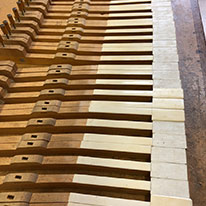 This piano was placed in storage for a few years. The storage facility was hot/dry and cold/damp. The owner wrongly believed that a few blankets would protect the piano against rust, changes in temperature and humidity.
This piano was placed in storage for a few years. The storage facility was hot/dry and cold/damp. The owner wrongly believed that a few blankets would protect the piano against rust, changes in temperature and humidity.
Unlike humans, pianos do not have blood or a metabolism to regulate temperature or moisture content in wood!
At best, the blankets kept dust off the piano, but most of the ivories had come off due to expanding and shrinking wood.
All ivories were properly glued back onto the keys and polished super smooth to a high gloss. You could not see that they ever had come off.
For more information on storage, go to “Moving or storing a piano.”
For more information on restorations go to “Restorations.”

